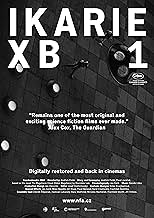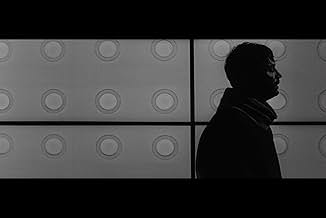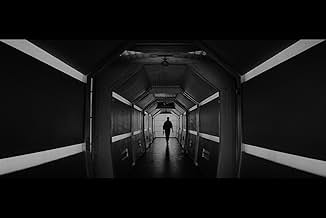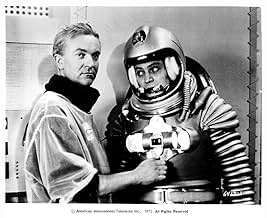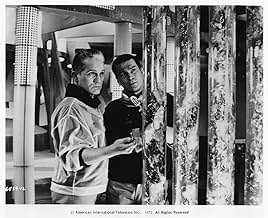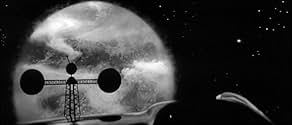Ikarie XB 1
- 1963
- Tous publics
- 1h 26min
NOTE IMDb
6,9/10
3,2 k
MA NOTE
Nous sommes en 2163. Le vaisseau spatial Ikarie XB 1 part pour un long voyage à travers l'univers, à la recherche de la vie sur les planètes d'Alpha du Centaure.Nous sommes en 2163. Le vaisseau spatial Ikarie XB 1 part pour un long voyage à travers l'univers, à la recherche de la vie sur les planètes d'Alpha du Centaure.Nous sommes en 2163. Le vaisseau spatial Ikarie XB 1 part pour un long voyage à travers l'univers, à la recherche de la vie sur les planètes d'Alpha du Centaure.
- Réalisation
- Scénario
- Casting principal
- Récompenses
- 1 victoire au total
Avis à la une
This is for sf-film completists. It seems to fill a gap between the late-50's style of sf movie and the forever-after effects of Star Trek and Kubrick's "2001." The only version you're likely to see is the American International release. The Encyclopedia of SF says the original film is in color, but AI's print is B&W, probably to save costs on the number of prints they may have made from a film I suspect they got for little money in the first place.
The story is about a big "community" sized spaceship making a long journey to "the green planet." Another reviewer said the ship was faster than light, but a couple of references to time-dilation effects in the dialog make it more likely that the ship was a near-lightspeed model. This has an influence on the spooky atmosphere that pervades the whole film, making the crew/community highly insular, as they realize they are cut off completely from the lives they have left behind.
The sfx are slightly better than Dr. Who episodes of similar vintage, with a couple of really good spacesuits and an unusual design for the ship itself. There's also a very, very neat shot of the ship in orbit around its destination that is a dead ringer for a similar moment in "Alien," and quite effective (in both films), in a way that most movies about spaceships seem to forego.
Still, the story rambles and seems kind of shallow. The sets and sfx aren't bad, but don't make up for the weak script. I recommend this for true lovers of the form (as I am), because you just wouldn't want to be left wondering what might have been going on in sf films, even east European ones, in the early '60s. Here's your answer.
The story is about a big "community" sized spaceship making a long journey to "the green planet." Another reviewer said the ship was faster than light, but a couple of references to time-dilation effects in the dialog make it more likely that the ship was a near-lightspeed model. This has an influence on the spooky atmosphere that pervades the whole film, making the crew/community highly insular, as they realize they are cut off completely from the lives they have left behind.
The sfx are slightly better than Dr. Who episodes of similar vintage, with a couple of really good spacesuits and an unusual design for the ship itself. There's also a very, very neat shot of the ship in orbit around its destination that is a dead ringer for a similar moment in "Alien," and quite effective (in both films), in a way that most movies about spaceships seem to forego.
Still, the story rambles and seems kind of shallow. The sets and sfx aren't bad, but don't make up for the weak script. I recommend this for true lovers of the form (as I am), because you just wouldn't want to be left wondering what might have been going on in sf films, even east European ones, in the early '60s. Here's your answer.
This czech scifi made in 1963 is surprisingly fresh compared to most films within the scifi genre.
The story of a multinational crew heading to unknown planet and along its path has to deal with many dangerous situations, has to be one of the most used story lines in scifi.
Even though we've seen so many times this film uses a very lowkey, socialrealistic approach. More reminiscent of latter efforts like Alien (1979), Silent Running (1972), Outland (1981).
This film portrays the crew and its members, struggling with everyday problems. Like childbirth, parties, relationships in space etc.
There is also the fact that this film was made during communist rule in Czechoslovakia which might explain the lack of glamorous, action filled scenes. In fact the films hints that decadent, capitalistic society is doomed to fail.
But there is also hints that the communistic state might contain flaws as well.
Todays audience might be disapproving against the sometimes slow, socialrealistic tone/style of the film but I for one found it quite refreshing.
Well-made scifi films without action, ridiculous high tempo, is hard to come by, and I hope more people will see this film.
The story of a multinational crew heading to unknown planet and along its path has to deal with many dangerous situations, has to be one of the most used story lines in scifi.
Even though we've seen so many times this film uses a very lowkey, socialrealistic approach. More reminiscent of latter efforts like Alien (1979), Silent Running (1972), Outland (1981).
This film portrays the crew and its members, struggling with everyday problems. Like childbirth, parties, relationships in space etc.
There is also the fact that this film was made during communist rule in Czechoslovakia which might explain the lack of glamorous, action filled scenes. In fact the films hints that decadent, capitalistic society is doomed to fail.
But there is also hints that the communistic state might contain flaws as well.
Todays audience might be disapproving against the sometimes slow, socialrealistic tone/style of the film but I for one found it quite refreshing.
Well-made scifi films without action, ridiculous high tempo, is hard to come by, and I hope more people will see this film.
Somewhere between the Outer Limits and Star Trek lies this little science fiction gem from the former Czechoslovakia. This isn't I. Robot or that type of science fiction, which is Asimov wrapped up in a shiny steel and glass box. This is the actual story and not just the wrapping paper. It proudly carries on the tradition started by Forbidden Planet and This Island Earth, even though its not as exciting. It is actually more like the Magnetic Monster and the Outer Limits. This is science fiction done in crisp black and white. The screen may not be vivid, yet the special effects have an ethereally surreal quality. Mix that in with the futuristic Shostakovitch-like score and we have a compelling and eerie trip into the unknown.
The excitement and glory that comes from living and exploring space (Star Trek, Star Wars, etc.) is minimized in the movie. We get the basic day to day activities of the crew of the Ikarie, on its 28 month (15 years pass back on Earth) mission to our closest solar system, Alpha Centauri. We also get the dangers and rewards of hurling ourselves into the vast darkness.
It is the 22nd Century and we are out in the galaxy searching for life. The crew is comprised from a co-ed international pool. We never get to see Earth, yet we get a glimpse of what humans are like from the interactions of the crew (work, entertainment, nutritional intervals, exercise, reproduction and crisis). This is a future full of video screens, blasters, personal transmitters, turbo lifts, artificial gravity, Beatnik-like futuristic dancing and even Nike light up magnetic boots. This is the perfect/classical example of the sci-fi antithesis to Idiocracy. Humanity will improve with time.
The future is bright, shiny and worth waiting for. Man fixes the malaise of his species. We are never shown anything more lethal than a hand blaster, when it comes to weapons. On their mission, they encounter a perfectly preserved space relic from an Earth expedition of the 20th century. Let's just say our predecessors had very little nice things to say about us. Let's not forget that the 20th century contained two world wars, numerous genocides, the birth and use of the the atomic bomb.
One would also assume that a movie made in a Soviet influenced country would contain a certain amount of Communist and Pro-Soviet propaganda (for example, Planeta Bura). Thankfully this is all missing. About the biggest commentary comes from the critique of our 20th century counterparts. I found the only anti-capitalist message in the writing on the Earth relic. Everything inside is written in English, the ship was fully loaded with nuclear warheads and the the crew turned on each other. And even this critique is more of a jab at our collective selves then at full fledged opposition to capitalism.
If you are looking for epic space battles for the fate of the universe, look elsewhere because the crew kills absolutely no living thing. If you want 90 minutes of Georges Méliès mixed with Jules Verne, then you have found the perfect movie. I can easily see this movie as an influence on Kubrick's 2001, Rodenberry's Star Trek, Lucas' Star Wars and even Irwin Allen's Lost in Space. We even have a robot. He's definitely not as cool nor as good as Robby the Robot nor the robot that constantly saves the Robinsons.
We named him Patrick. Patrick the Robot. RIP. (Pour out some alcohol for the robots that aren't with us anymore).
-Celluloid Rehab
The excitement and glory that comes from living and exploring space (Star Trek, Star Wars, etc.) is minimized in the movie. We get the basic day to day activities of the crew of the Ikarie, on its 28 month (15 years pass back on Earth) mission to our closest solar system, Alpha Centauri. We also get the dangers and rewards of hurling ourselves into the vast darkness.
It is the 22nd Century and we are out in the galaxy searching for life. The crew is comprised from a co-ed international pool. We never get to see Earth, yet we get a glimpse of what humans are like from the interactions of the crew (work, entertainment, nutritional intervals, exercise, reproduction and crisis). This is a future full of video screens, blasters, personal transmitters, turbo lifts, artificial gravity, Beatnik-like futuristic dancing and even Nike light up magnetic boots. This is the perfect/classical example of the sci-fi antithesis to Idiocracy. Humanity will improve with time.
The future is bright, shiny and worth waiting for. Man fixes the malaise of his species. We are never shown anything more lethal than a hand blaster, when it comes to weapons. On their mission, they encounter a perfectly preserved space relic from an Earth expedition of the 20th century. Let's just say our predecessors had very little nice things to say about us. Let's not forget that the 20th century contained two world wars, numerous genocides, the birth and use of the the atomic bomb.
One would also assume that a movie made in a Soviet influenced country would contain a certain amount of Communist and Pro-Soviet propaganda (for example, Planeta Bura). Thankfully this is all missing. About the biggest commentary comes from the critique of our 20th century counterparts. I found the only anti-capitalist message in the writing on the Earth relic. Everything inside is written in English, the ship was fully loaded with nuclear warheads and the the crew turned on each other. And even this critique is more of a jab at our collective selves then at full fledged opposition to capitalism.
If you are looking for epic space battles for the fate of the universe, look elsewhere because the crew kills absolutely no living thing. If you want 90 minutes of Georges Méliès mixed with Jules Verne, then you have found the perfect movie. I can easily see this movie as an influence on Kubrick's 2001, Rodenberry's Star Trek, Lucas' Star Wars and even Irwin Allen's Lost in Space. We even have a robot. He's definitely not as cool nor as good as Robby the Robot nor the robot that constantly saves the Robinsons.
We named him Patrick. Patrick the Robot. RIP. (Pour out some alcohol for the robots that aren't with us anymore).
-Celluloid Rehab
Written by the same man who wrote Solaris, rather than a science fantasy, space opera, or race movie like many other scifi films of that era (many of which are just as excellent in their own way - see The Sky Calls, Planeta Bur, or Forbidden Planet, for example), Ikarie XB1 (aka Journey to the End of the Universe) is a serious-minded science fiction drama, with element of mystery and suspense.
My rating of 9 out of 10 Stars might be a little exuberant, but that was my reaction to the film. The sets are sumptuous, almost art deco, the black and white cinematography crisp and beautiful to look at, and the acting always competent or better. The score is largely electronic, with some distorted electric guitar, and no orchestral elements.
Ikarie XB1 is so different from a lot of other science fiction cinema being produced at the time that I found it to be a captivating surprise.
My rating of 9 out of 10 Stars might be a little exuberant, but that was my reaction to the film. The sets are sumptuous, almost art deco, the black and white cinematography crisp and beautiful to look at, and the acting always competent or better. The score is largely electronic, with some distorted electric guitar, and no orchestral elements.
Ikarie XB1 is so different from a lot of other science fiction cinema being produced at the time that I found it to be a captivating surprise.
This is an intriguing Czech science fiction film from the early 60's. It's pretty much unknown in the U.S (American - International Pictures dubbed it into English and released it as "Voyage to the End of the Universe" in 1964; it's been seen here only rarely since then).
The movie depicts a group of space travelers on a seemingly endless journey to a new planet. They encounter many traps and dangers along the way (including a derelict spacecraft and a mysterious nebula) but the greatest conflict seems to be psychological: namely, the titanic ambition of a 15-year, trans-galactic voyage pitted against the fragility of the human mind and the relative insignificance of human lives.
The interior sets are lavish -- certainly on a par with "Forbidden Planet" and perhaps even "2001". The level of detail in the spaceship interiors is admirable, and the same can be said for the smartly designed spacesuits.
"Ikarie XB 1" stumbles badly, though, when it comes to the exterior effects work. The spacecraft models are too small to provide much detail, and seem to be propelled through space by dark-colored string. As a result the transitions between interior and exterior shots are somewhat jarring.
All the same, this movie is a very interesting example of mid-century science fiction. It deserves a much wider audience, and it is to be hoped that a restored, subtitled print will one day make the rounds in American art houses. Cross your fingers.
The movie depicts a group of space travelers on a seemingly endless journey to a new planet. They encounter many traps and dangers along the way (including a derelict spacecraft and a mysterious nebula) but the greatest conflict seems to be psychological: namely, the titanic ambition of a 15-year, trans-galactic voyage pitted against the fragility of the human mind and the relative insignificance of human lives.
The interior sets are lavish -- certainly on a par with "Forbidden Planet" and perhaps even "2001". The level of detail in the spaceship interiors is admirable, and the same can be said for the smartly designed spacesuits.
"Ikarie XB 1" stumbles badly, though, when it comes to the exterior effects work. The spacecraft models are too small to provide much detail, and seem to be propelled through space by dark-colored string. As a result the transitions between interior and exterior shots are somewhat jarring.
All the same, this movie is a very interesting example of mid-century science fiction. It deserves a much wider audience, and it is to be hoped that a restored, subtitled print will one day make the rounds in American art houses. Cross your fingers.
Le saviez-vous
- AnecdotesThe music played on piano after the derelict ship explodes is "Part One: Introduction" from "King David", aka "Le Roi David," composed by Arthur Honegger.
- Versions alternativesSPOILER: For the American release, titled "Voyage to the End of the Universe," American International Pictures cut the film up, changing a number of things:
- Approximately 26 minutes of footage were removed (including a sequence in a man-made flying saucer carrying dead capitalists, nerve gas and an atomic bomb).
- The story was changed substantially, the ship's flight direction reversed (making it an alien ship traveling to Earth), and the Statue of Liberty pasted into the final shot.
- The cast and staff's names in the credits were altered significantly to look like English.
Meilleurs choix
Connectez-vous pour évaluer et suivre la liste de favoris afin de recevoir des recommandations personnalisées
- How long is Voyage to the End of the Universe?Alimenté par Alexa
Détails
Box-office
- Montant brut mondial
- 2 130 $US
- Durée
- 1h 26min(86 min)
- Couleur
- Mixage
- Rapport de forme
- 2.35 : 1
Contribuer à cette page
Suggérer une modification ou ajouter du contenu manquant

